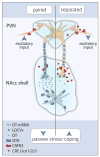Lost connections: Oxytocin and the neural, physiological, and behavioral consequences of disrupted relationships
- PMID: 29330007
- PMCID: PMC6037618
- DOI: 10.1016/j.ijpsycho.2017.12.011
Lost connections: Oxytocin and the neural, physiological, and behavioral consequences of disrupted relationships
Abstract
In humans and rodent animal models, the brain oxytocin system is paramount for facilitating social bonds, from the formation and consequences of early-life parent-infant bonds to adult pair bond relationships. In social species, oxytocin also mediates the positive effects of healthy social bonds on the partners' well-being. However, new evidence suggests that the negative consequences of early neglect or partner loss may be mediated by disruptions in the oxytocin system as well. With a focus on oxytocin and its receptor, we review studies from humans and animal models, i.e. mainly from the biparental, socially monogamous prairie vole (Microtus ochrogaster), on the beneficial effects of positive social relationships both between offspring and parents and in adult partners. The abundance of social bonds and benevolent social relationships, in general, are associated with protective effects against psycho- and physiopathology not only in the developing infant, but also during adulthood. Furthermore, we discuss the negative effects on well-being, emotionality and behavior, when these bonds are diminished in quality or are disrupted, for example through parental neglect of the young or the loss of the partner in adulthood. Strikingly, in prairie voles, oxytocinergic signaling plays an important developmental role in the ability to form bonds later in life in the face of early-life neglect, while disruption of oxytocin signaling following partner loss results in the emergence of depressive-like behavior and physiology. This review demonstrates the translational value of animal models for investigating the oxytocinergic mechanisms that underlie the detrimental effects of developmental parental neglect and pair bond disruption, encouraging future translationally relevant studies on this topic that is so central to our daily lives.
Copyright © 2018 Elsevier B.V. All rights reserved.
Figures


Similar articles
-
Oxytocin and Social Relationships: From Attachment to Bond Disruption.Curr Top Behav Neurosci. 2018;35:97-117. doi: 10.1007/7854_2017_10. Curr Top Behav Neurosci. 2018. PMID: 28812266 Free PMC article. Review.
-
Behavioral and cardiovascular consequences of disrupted oxytocin communication in cohabitating pairs of male and female prairie voles.Soc Neurosci. 2019 Dec;14(6):649-662. doi: 10.1080/17470919.2019.1572031. Epub 2019 Jan 31. Soc Neurosci. 2019. PMID: 30658044 Free PMC article.
-
Neurochemical regulation of pair bonding in male prairie voles.Physiol Behav. 2004 Nov 15;83(2):319-28. doi: 10.1016/j.physbeh.2004.08.024. Physiol Behav. 2004. PMID: 15488548 Review.
-
The neurobiology of pair bond formation, bond disruption, and social buffering.Curr Opin Neurobiol. 2016 Oct;40:8-13. doi: 10.1016/j.conb.2016.05.006. Epub 2016 Jun 9. Curr Opin Neurobiol. 2016. PMID: 27290660 Free PMC article. Review.
-
Oxytocin receptor antagonist reverses the blunting effect of pair bonding on fear learning in monogamous prairie voles.Horm Behav. 2020 Apr;120:104685. doi: 10.1016/j.yhbeh.2020.104685. Epub 2020 Jan 24. Horm Behav. 2020. PMID: 31935400 Free PMC article.
Cited by
-
How prior pair-bonding experience affects future bonding behavior in monogamous prairie voles.Horm Behav. 2020 Nov;126:104847. doi: 10.1016/j.yhbeh.2020.104847. Epub 2020 Sep 30. Horm Behav. 2020. PMID: 32910950 Free PMC article.
-
Effects of Chronic and Acute Intranasal Oxytocin Treatments on Temporary Social Separation in Adult Titi Monkeys (Plecturocebus cupreus).Front Behav Neurosci. 2022 Jun 22;16:877631. doi: 10.3389/fnbeh.2022.877631. eCollection 2022. Front Behav Neurosci. 2022. PMID: 35813591 Free PMC article.
-
Maternal stress and the MPOA: Activation of CRF receptor 1 impairs maternal behavior and triggers local oxytocin release in lactating rats.Neuropharmacology. 2018 May 1;133:440-450. doi: 10.1016/j.neuropharm.2018.02.019. Epub 2018 Mar 2. Neuropharmacology. 2018. PMID: 29477300 Free PMC article.
-
Dwelling in prolonged grief: Resting state functional connectivity during oxytocin and placebo administration.Hum Brain Mapp. 2023 Jan;44(1):245-257. doi: 10.1002/hbm.26071. Epub 2022 Sep 10. Hum Brain Mapp. 2023. PMID: 36087094 Free PMC article. Clinical Trial.
-
Epigenetic Mechanisms in the Neurodevelopmental Theory of Depression.Depress Res Treat. 2020 Apr 24;2020:6357873. doi: 10.1155/2020/6357873. eCollection 2020. Depress Res Treat. 2020. PMID: 32373361 Free PMC article. Review.
References
-
- Agorastos A, Pittman JO, Angkaw AC, Nievergelt CM, Hansen CJ, Aversa LH, Parisi SA, Barkauskas DA, Baker DG The Marine Resiliency Study Team. The cumulative effect of different childhood trauma types on self-reported symptoms of adult male depression and PTSD, substance abuse and health-related quality of life in a large active-duty military cohort. J Psychiatr Res. 2014;58:46–54. doi: 10.1016/j.jpsychires.2014.07.014. - DOI - PubMed
-
- Ahern TH, Young LJ. The impact of early life family structure on adult social attachment, alloparental behavior, and the neuropeptide systems regulating affiliative behaviors in the monogamous prairie vole (microtus ochrogaster) Front Behav Neurosci. 2009;3:17. doi: 10.3389/neuro.08.017.2009. - DOI - PMC - PubMed
Publication types
MeSH terms
Substances
Grants and funding
LinkOut - more resources
Full Text Sources
Other Literature Sources
Medical

